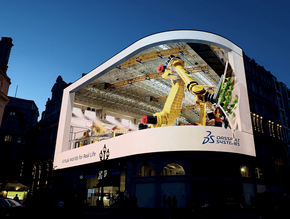McKinsey Report: US Manufacturing Faces Major Hiring Crisis

Manufacturing is facing a global hiring crisis.
With an ageing workforce that lacks digital skills, the sector must attract young talent. This is proving difficult despite overwhelming demand, a pattern that is observable across global supply chain operations.
This is due to factors that have been expanded upon in McKinsey’s recent research, which ranks the manufacturing roles hardest to fill.
In ‘Tradespeople wanted: The need for critical trade skills in the US’ the consultancy explores the challenges US Manufacturing is having with hiring, facing a 4.1% lull in hiring rates despite consistent job openings. Due to the transition to clean energy, emerging real estate development and rising infrastructure needs, the US needs a dramatic increase in its manufacturing workforce.
McKinsey predicts annual hiring to be 20 times more this year than the annual increase in net new jobs experienced between 2022 and 2023. It also predicts manufacturers will experience a rate of churn costing them $US5.3bn each year, in training costs and talent acquisition alone.
The research identifies several critical roles which have a major impact on manufacturing operations and its broader economy. Using statistics from the US Bureau of Labour, McKinsey has made this categorisation based on the following criteria.
- Importance to advanced manufacturing, public and private infrastructure and clean-energy projects.
- How frequently these positions migrate to other jobs and how much of this position's workforce is entering retirement.
- How extensive the training requirements are for the position and the impact this has had on slowing down career progression.
With these criteria, McKinsey identified these manufacturing job categories as the most difficult to fill with skilled workers:

Electricians
- Critical to manufacturing and construction industries, along with the transition to clean energy are electricians. 30% of union electricians are expected to reach retirement age in the next decade.
- Typical apprenticeship timelines are four to five years, meaning manufacturers risk losing in-group knowledge and individuals risk failing to acquire skills they have few opportunities to use before experienced colleagues retire.
- Digital transformation means that by the time new electricians finish apprenticeships some of their skills may be obsolete.
- 70% of supervisors in the electrical industry are baby boomers, leading to a future scarcity of frontline leaders.

Welders
- 70% of all manufactured products require the skills of welders, and both construction and manufacturing compete for the same talent.
- 584,000 job openings for welders have been listed by the US manufacturing industry since January 2024, the majority remain unfilled.
- Shortages of welders strain production, hinder economic growth, lower productivity and introduce quality concerns.
- It’s estimated that in ten years, just 2.7% of 2022 welder jobs will be kept, a finding attributed to retirement and churn.

Construction Workers
- In December 2023, the US construction industry had roughly 374,000 job openings.
- According to a 2023 Associated General Contractors of America survey, 70% of respondents are concerned about an insufficient supply of workers or subcontractors.
- 80% of respondents in the same survey are facing difficulty filling some or all of these positions.
- 83% of construction workers themselves list inexperienced workers as the largest safety concern, highlighting the gravity of this problem.
- Challenges in filling vacancies are hampering quality control, raising costs and delaying projects. As megaprojects accelerate this will only grow worse.
Addressing the hiring crisis in US supply chain manufacturing
Addressing this hiring challenge is going to take collective effort across social, private and public sectors. There needs to be a renewed effort both in the United States and globally to nurture the next generation of talent to enter manufacturing, providing digitally conscious training, support and benefits.
In the research, McKinsey highlights the use of regional solutions to fill talent pools, where local employers, educators and government collaborate to increase the ROI of talent supply initiatives.
The research also demonstrates the need for manufacturers to be proactive with skilled trade talent, taking action to reduce churn and boost productivity. This requires the transformation of talent and operating models, managing economic headwinds such as inflation and investing in continuous training and improvement across the enterprise.
The research concludes that US manufacturers must focus on three key practices to find and retain skilled labour. I believe these practices can be extrapolated to global manufacturing, as it’s beset with similar challenges.
1. Invest in collaborative tech
This investment has short and long-term benefits, reducing current pressures on hiring and labour demands and enhancing the digital skills of the future workforce. Collaborative robots have been shown to improve resource utilisation by 50% and enhance productivity by 40% when used alongside humans.
2. Emphasise diverse hiring
McKinsey argues that the shrinking size of the US manufacturing workforce can also be attributed to a lack of diversity, particularly in technical roles. People of colour make up 40% of the manufacturing workforce, and women only account for single digits. This is a huge hiring pool that manufacturing needs to tap into.
3. Get the next generation into manufacturing
Younger workers prioritise career development and advancement as top factors when taking on a new job. Workplace flexibility - often favouring remote working- is important to the majority as well. The on-site and structured nature of manufacturing jobs makes it harder to align with these generational preferences. This is why companies must offer benefits and compromises to appeal as employers, along with the wider industry making an effort to reach out and educate about the industry.
Ultimately US manufacturing, like global manufacturing, will need to meet major generational and technological changes with proactive action if it is to overcome current hiring woes. Construction labourers, electricians and welders are the backbone of the industry, with high-value skills that are essential to global supply chains. The world depends upon their work, it maintains economies and ensures consistent food production, transport and infrastructure. Developing skilled future talent to take on these positions is critical, not just for the financial future of companies, but also for the future of manufacturing and modern technological development.
******
Make sure you check out the latest edition of Manufacturing Digital and also sign up to our global conference series - Procurement & Supply Chain 2024 & Sustainability LIVE 2024
******
Manufacturing Digital is a BizClik brand.
- WEF, Kearney Report: Manufacturing’s Rhetoric vs RealitiesProduction & Operations
- Immensa and Intaj Suhar partner to boost Omani manufacturingProcurement & Supply Chain
- Daikin Applied's Dedication to Sustainable ManufacturingProduction & Operations
- Top 10: Chief Manufacturing OfficersProduction & Operations






